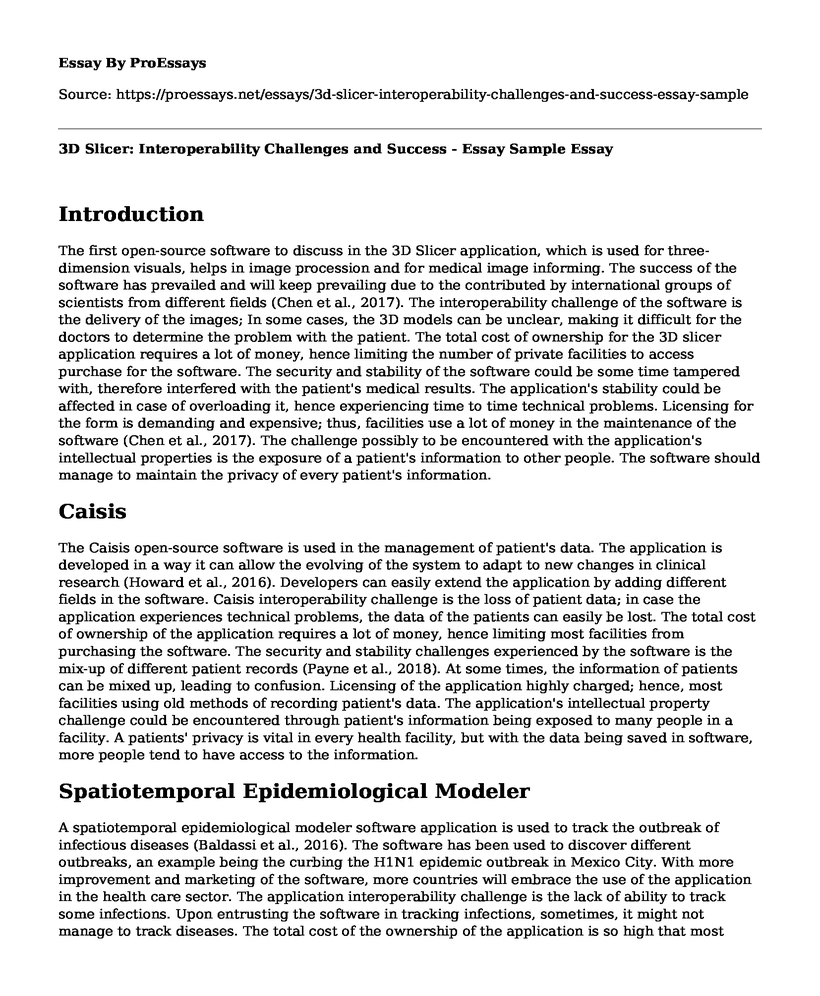Introduction
The first open-source software to discuss in the 3D Slicer application, which is used for three-dimension visuals, helps in image procession and for medical image informing. The success of the software has prevailed and will keep prevailing due to the contributed by international groups of scientists from different fields (Chen et al., 2017). The interoperability challenge of the software is the delivery of the images; In some cases, the 3D models can be unclear, making it difficult for the doctors to determine the problem with the patient. The total cost of ownership for the 3D slicer application requires a lot of money, hence limiting the number of private facilities to access purchase for the software. The security and stability of the software could be some time tampered with, therefore interfered with the patient's medical results. The application's stability could be affected in case of overloading it, hence experiencing time to time technical problems. Licensing for the form is demanding and expensive; thus, facilities use a lot of money in the maintenance of the software (Chen et al., 2017). The challenge possibly to be encountered with the application's intellectual properties is the exposure of a patient's information to other people. The software should manage to maintain the privacy of every patient's information.
Caisis
The Caisis open-source software is used in the management of patient's data. The application is developed in a way it can allow the evolving of the system to adapt to new changes in clinical research (Howard et al., 2016). Developers can easily extend the application by adding different fields in the software. Caisis interoperability challenge is the loss of patient data; in case the application experiences technical problems, the data of the patients can easily be lost. The total cost of ownership of the application requires a lot of money, hence limiting most facilities from purchasing the software. The security and stability challenges experienced by the software is the mix-up of different patient records (Payne et al., 2018). At some times, the information of patients can be mixed up, leading to confusion. Licensing of the application highly charged; hence, most facilities using old methods of recording patient's data. The application's intellectual property challenge could be encountered through patient's information being exposed to many people in a facility. A patients' privacy is vital in every health facility, but with the data being saved in software, more people tend to have access to the information.
Spatiotemporal Epidemiological Modeler
A spatiotemporal epidemiological modeler software application is used to track the outbreak of infectious diseases (Baldassi et al., 2016). The software has been used to discover different outbreaks, an example being the curbing the H1N1 epidemic outbreak in Mexico City. With more improvement and marketing of the software, more countries will embrace the use of the application in the health care sector. The application interoperability challenge is the lack of ability to track some infections. Upon entrusting the software in tracking infections, sometimes, it might not manage to track diseases. The total cost of the ownership of the application is so high that most facilities do not use the software at all. The security and stability of the software can, at times, not be relatable since, in the case where the software does not track an infection, people are put in a higher risk of being infected (Santermans et al., 2016). The licensing of the software is demanding; therefore, it is only used at critical conditions such as a national crisis. The intellectual property challenge of the software is the inability to track infections, or at times giving the wrong results hence leading to people being treated on the false diseases, which could lead to worsening of their health.
References
Baldassi, F., D'AMICO, F., Carestia, M., Cenciarelli, O., Mancinelli, S., Gilardi, F., ... & Gaudio, P. (2016). Testing the accuracy ratio of the Spatio-Temporal Epidemiological Modeler (STEM) through Ebola hemorrhagic fever outbreaks. Epidemiology & Infection, 144(7), 1463-1472.
Chen, J. G., Han, K. W., Zhang, D. F., Li, Z. X., Li, Y. M. & Hou, L. J. (2017). Presurgical planning for supratentorial lesions with a free Slicer software and Sina app. World neurosurgery, 106, 193-197.
Howard, N., Corcoran, N., Peters, J., Moon, D., Murphy, D., Kerger, M., ... & Costello, A. (2016). Caisis: A Prostate Cancer Database Management System for Translational Research.
Payne, J. I., Dunbar, M. J., Talbot, P., & Tan, M. H. (2018). Diabetes Care Program of Nova Scotia: Celebrating 25 Years of Improving Diabetes Care in Nova Scotia. Canadian Journal of Diabetes, 42(3), 317-324.
Santermans, E., Robesyn, E., Ganyani, T., Sudre, B., Faes, C., Quinten, C., ... & Testa, M. (2016). Spatiotemporal evolution of Ebola virus disease at a sub-national level during the 2014 West Africa epidemic: model scrutiny and data meagreness. PloS one, 11(1), e0147172.
Cite this page
3D Slicer: Interoperability Challenges and Success - Essay Sample. (2023, Mar 14). Retrieved from https://proessays.net/essays/3d-slicer-interoperability-challenges-and-success-essay-sample
If you are the original author of this essay and no longer wish to have it published on the ProEssays website, please click below to request its removal:
- Google Leadership
- Research Paper on Children and Technology
- Personal Statement for My Innovative Techniques
- Essay Sample on Internet Domain Name Clashes: Legal & Ethical Issues
- The Internet & E-Commerce: A Global Connection - Research Paper
- Small Businesses: Protecting Against Cyberattacks & Minimizing Risks - Essay Sample
- Free Report - Securing Bi Visual Solutions: Operating System and Database Infrastructure







